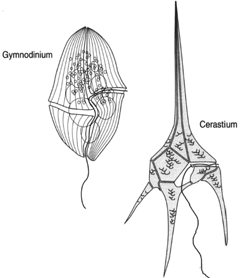Pyrrophyta
Two classes are recognized in the phylum Pyrrophyta: Dinophyceae (dinoflagellates) and Cryptophyceae (cryptomonads). Because all are unicellular, they are classified in the kingdom Protista. There are approximately one thousand mostly marine, mostly motile species. A few are colonial or filamentous. Chlorophylls a and c are present, as are carotenoids and xanthophylls. Peridinin, a reddish-brown pigment, is largely responsible for the color of these organisms. The product of photosynthesis is starch. The method of cell division is unusual. The chromosomes inside the nuclear membrane remain visible at all times, not seeming to lose their organization, as happens in normal mitosis. Further, the nuclear membrane remains intact during cell division. Some organisms have cellulose walls; those that don’t instead have .pellicles. Motile forms have two flagella. A longer flagellum lies in a groove called the sulcus, and a shorter flagellum lies perpendicular to the first in a groove called the girdle. The positioning of the flagella causest he cell to swim in a rotating motion.Dinophyceae: The Dinoflagellates
The prefix dino- here refers to the whirling motion of the cells as they swim along. The rate at which they can move is thousands of times faster than is noted in diatoms. The chief method of reproduction is longitudinal cell division, whereby one cell gets one of the flagella and a portion of the body covering, and then, in growing, supplies the missing parts. These species are similar to Euglena in the sense that they can absorb nutrients from the water and, while photosynthetic, can thrive in darkness. It has been suggested that they can also ingest small, solid, food particles. The dinoflagellates may be studied in zoology as well as in botany.
The dinoflagellates have two distinctive traits: they are luminescent, and they are poisonous. Light production is related ttoh e pigment luciferin being acted on by the enzyme luciferase, a conversion that produces light without heat. This light reaction seems to be stimulated by disturbance such as when a boat goes through the water; at night, light is seen at the bow. Noctiluca and Gonyaulax are examples of bioluminescent dinoflagellates. Dinoflagellates produce severe toxintsh at can kill fish and sometimes people. These toxins act on the nervous system, causing paralysis. Interestingly, mussels that consume such dinoflagellates seem not to suffer any damaging effects. Given that the toxins of such dinoflagellates concentrate in the bodies of mussels, however, great harm would befd any person who consumed them.
 |
| Figure 16-9 Dinoflagellates |
Cryptophyceae: The Cryptomonads
There are approximately a hundred species of Cryptophyceae. In addition to the already noted characteristics of the phylum, members of this class have bilaterally compressed cell walls. While photosynthetic, some seem also to be heterotrophic (able to take in nutrients through the cell membrane). They seem to require an external source of vitamins (again suggesting a resemblance to Euglena). They are considered by some to be closely related to protozoa.




